Cyber Warfare: Analyzing the Fog of War and Decision-Making Processes
VerifiedAdded on 2020/05/08
|10
|2032
|38
Report
AI Summary
This report provides an analysis of cyber warfare, focusing on the concept of the "Fog of War" and its implications on decision-making processes. It explores how the information environment shapes strategic choices in cyber conflicts, discussing the challenges of gathering and leveraging data in a timely manner. The report examines various threats, including targeted countermeasures, hunting for malicious activities, and deception technologies. It also highlights the importance of Multiple Attribute Decision-Making (MADM) approaches in cyber warfare scenarios, where limited alternatives exist. Furthermore, the report delves into the critical discussions surrounding the ambiguities of war and the impact of friction and unexpected events on operational plans. It concludes by emphasizing the importance of understanding the fog of war and its influence on judgment and the need for constraint management to streamline operations and achieve optimal outcomes.
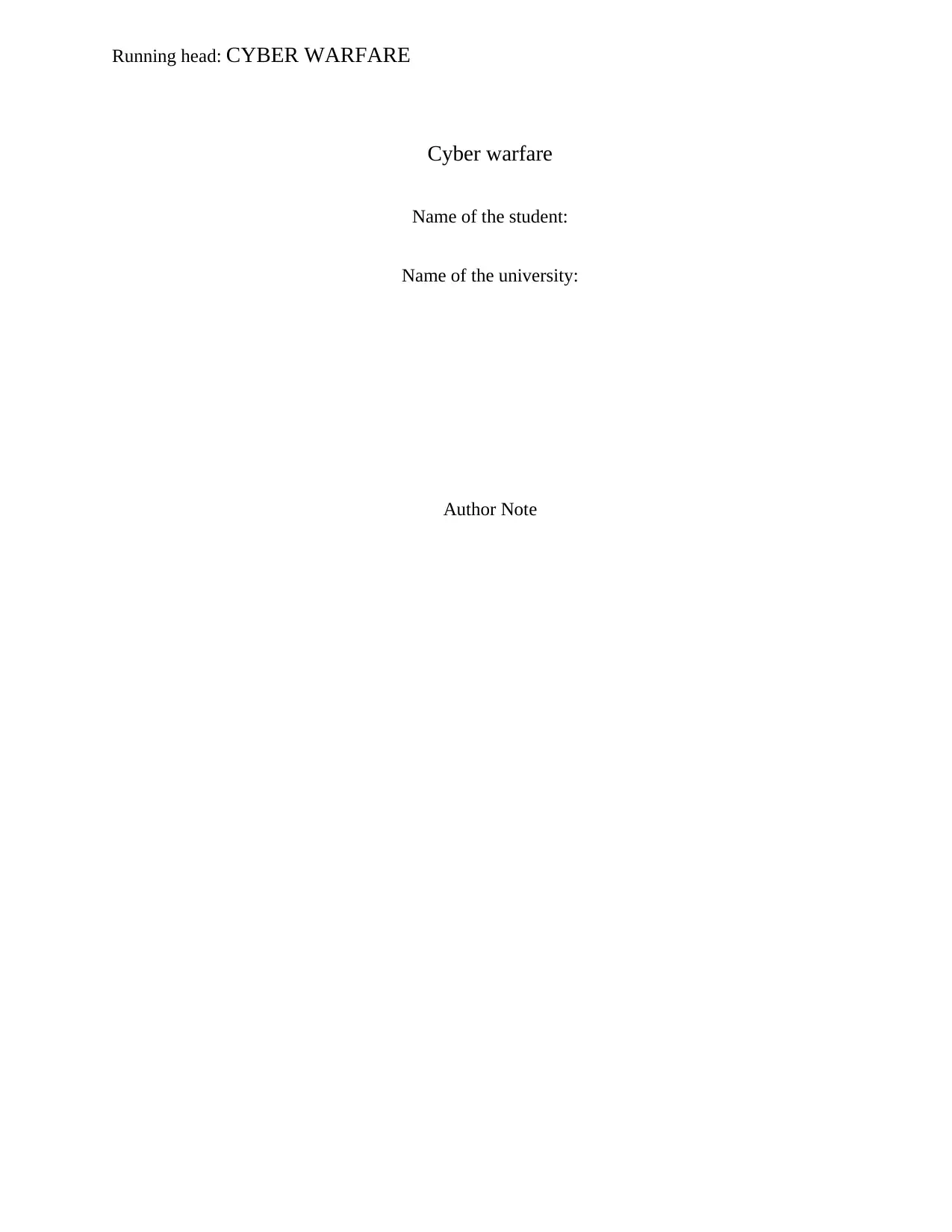
Running head: CYBER WARFARE
Cyber warfare
Name of the student:
Name of the university:
Author Note
Cyber warfare
Name of the student:
Name of the university:
Author Note
Paraphrase This Document
Need a fresh take? Get an instant paraphrase of this document with our AI Paraphraser
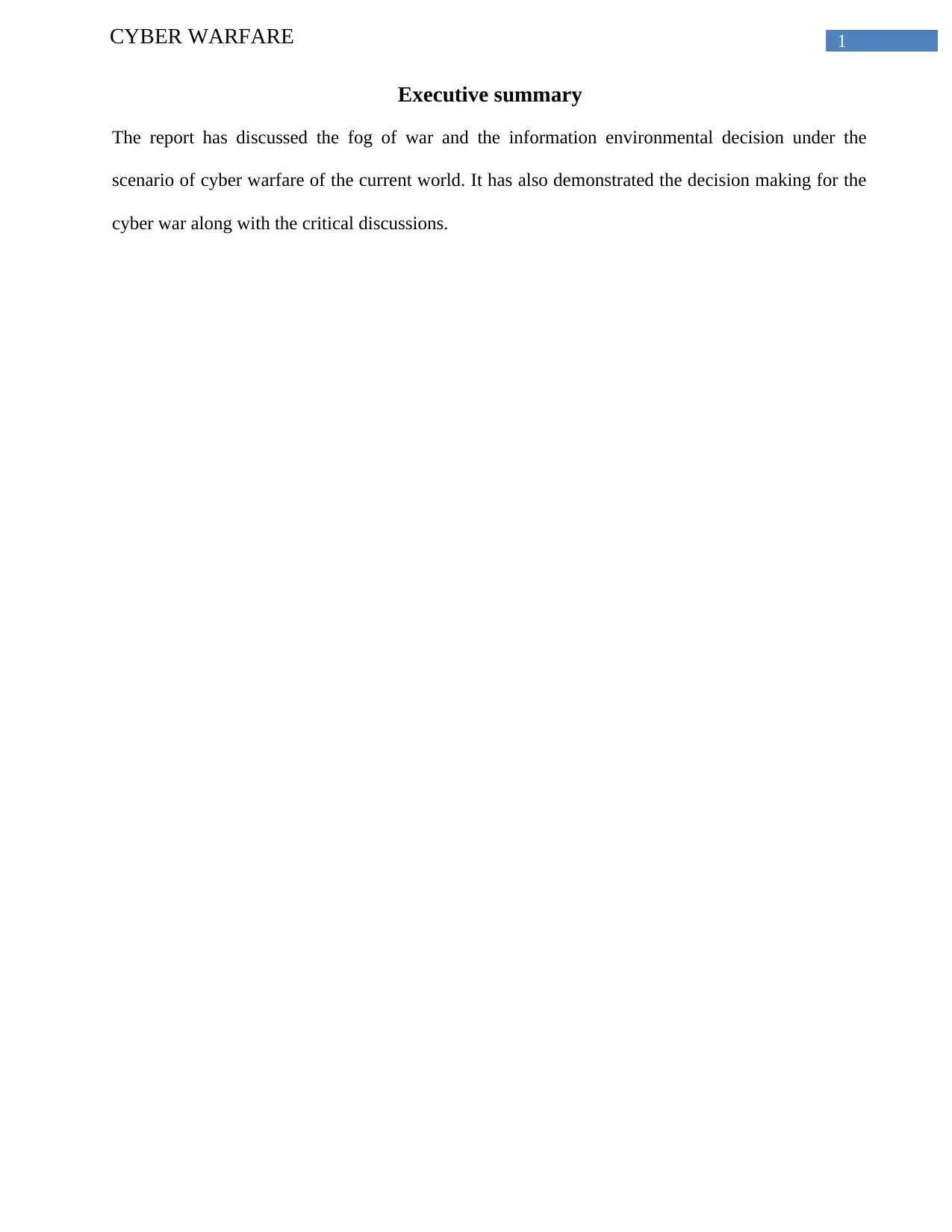
1CYBER WARFARE
Executive summary
The report has discussed the fog of war and the information environmental decision under the
scenario of cyber warfare of the current world. It has also demonstrated the decision making for the
cyber war along with the critical discussions.
Executive summary
The report has discussed the fog of war and the information environmental decision under the
scenario of cyber warfare of the current world. It has also demonstrated the decision making for the
cyber war along with the critical discussions.
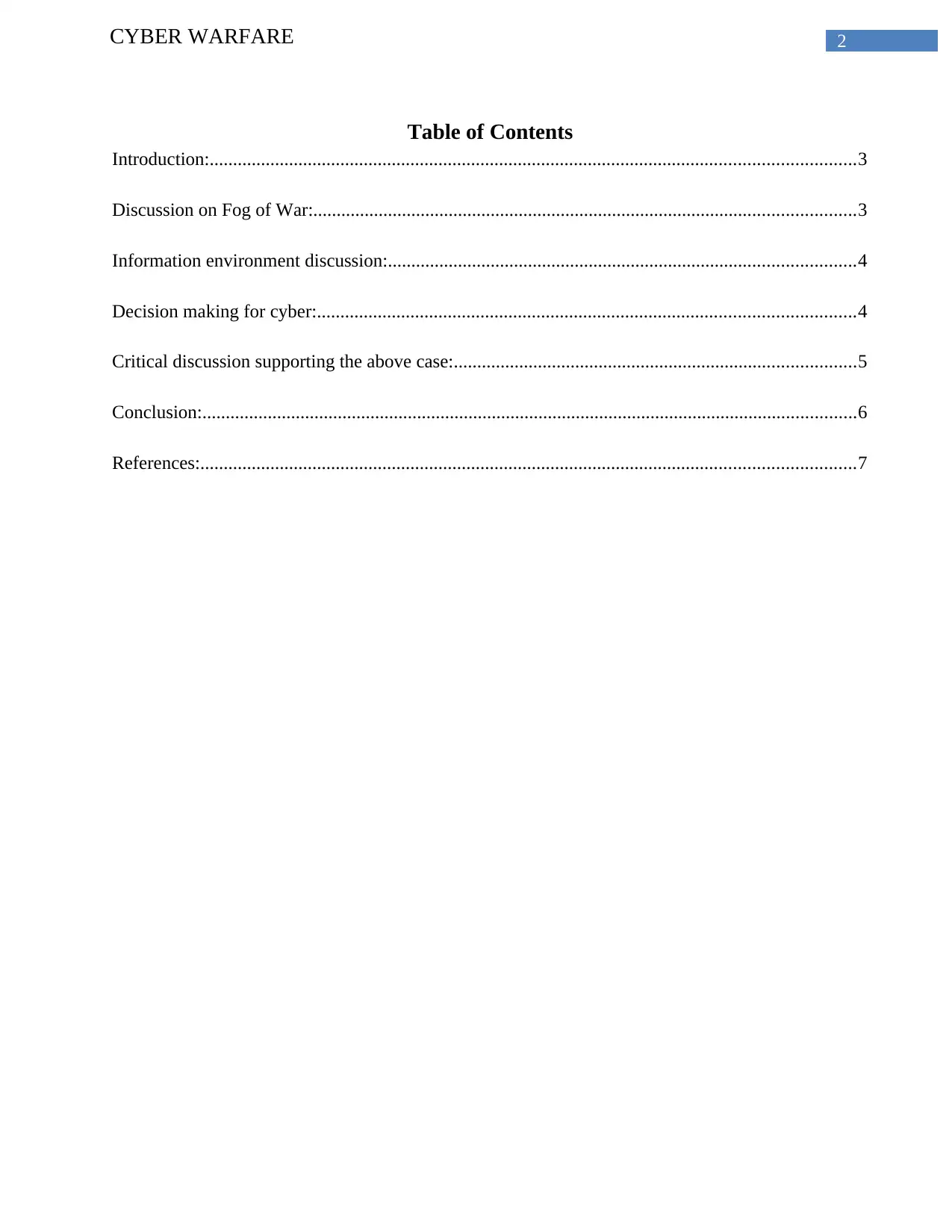
2CYBER WARFARE
Table of Contents
Introduction:..........................................................................................................................................3
Discussion on Fog of War:....................................................................................................................3
Information environment discussion:....................................................................................................4
Decision making for cyber:...................................................................................................................4
Critical discussion supporting the above case:......................................................................................5
Conclusion:............................................................................................................................................6
References:............................................................................................................................................7
Table of Contents
Introduction:..........................................................................................................................................3
Discussion on Fog of War:....................................................................................................................3
Information environment discussion:....................................................................................................4
Decision making for cyber:...................................................................................................................4
Critical discussion supporting the above case:......................................................................................5
Conclusion:............................................................................................................................................6
References:............................................................................................................................................7
⊘ This is a preview!⊘
Do you want full access?
Subscribe today to unlock all pages.

Trusted by 1+ million students worldwide
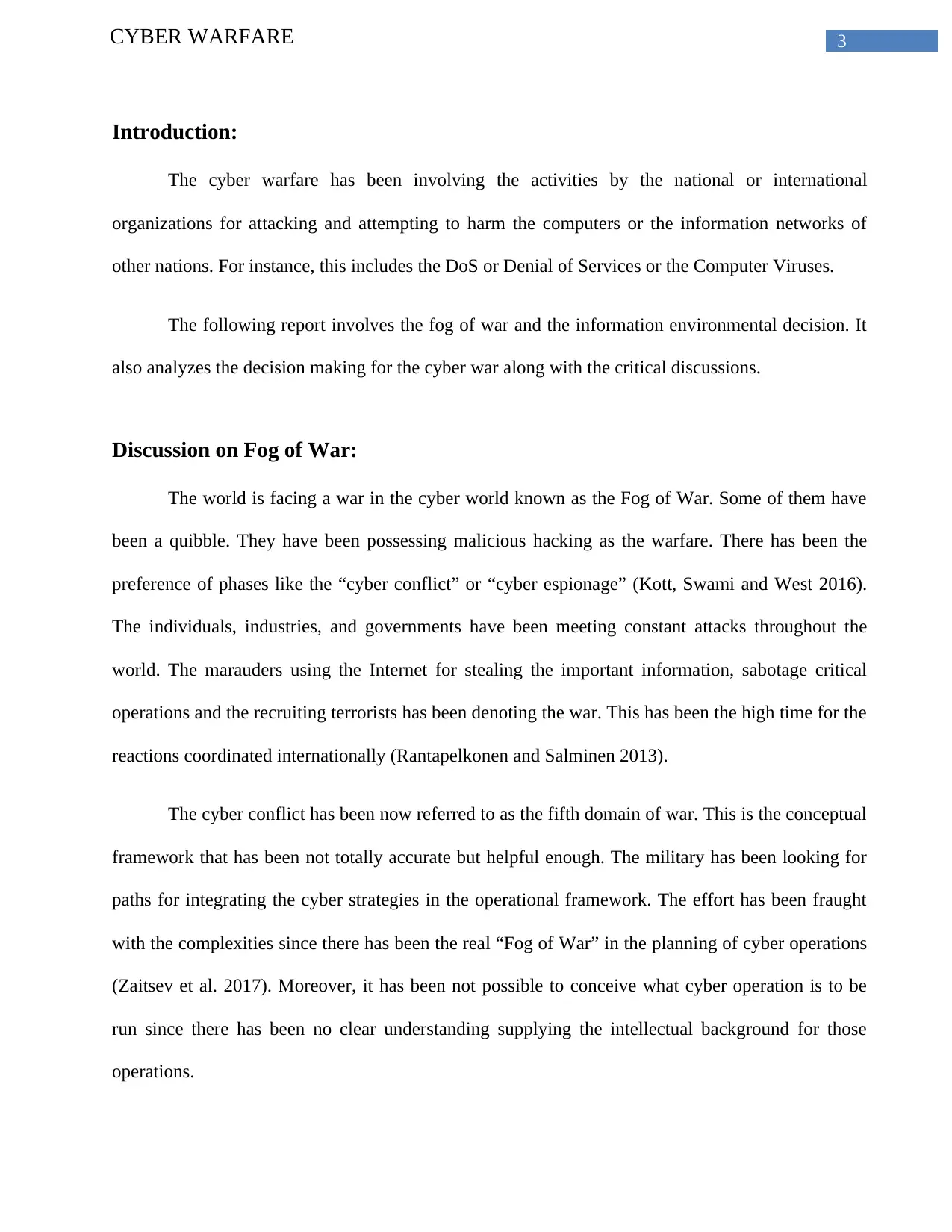
3CYBER WARFARE
Introduction:
The cyber warfare has been involving the activities by the national or international
organizations for attacking and attempting to harm the computers or the information networks of
other nations. For instance, this includes the DoS or Denial of Services or the Computer Viruses.
The following report involves the fog of war and the information environmental decision. It
also analyzes the decision making for the cyber war along with the critical discussions.
Discussion on Fog of War:
The world is facing a war in the cyber world known as the Fog of War. Some of them have
been a quibble. They have been possessing malicious hacking as the warfare. There has been the
preference of phases like the “cyber conflict” or “cyber espionage” (Kott, Swami and West 2016).
The individuals, industries, and governments have been meeting constant attacks throughout the
world. The marauders using the Internet for stealing the important information, sabotage critical
operations and the recruiting terrorists has been denoting the war. This has been the high time for the
reactions coordinated internationally (Rantapelkonen and Salminen 2013).
The cyber conflict has been now referred to as the fifth domain of war. This is the conceptual
framework that has been not totally accurate but helpful enough. The military has been looking for
paths for integrating the cyber strategies in the operational framework. The effort has been fraught
with the complexities since there has been the real “Fog of War” in the planning of cyber operations
(Zaitsev et al. 2017). Moreover, it has been not possible to conceive what cyber operation is to be
run since there has been no clear understanding supplying the intellectual background for those
operations.
Introduction:
The cyber warfare has been involving the activities by the national or international
organizations for attacking and attempting to harm the computers or the information networks of
other nations. For instance, this includes the DoS or Denial of Services or the Computer Viruses.
The following report involves the fog of war and the information environmental decision. It
also analyzes the decision making for the cyber war along with the critical discussions.
Discussion on Fog of War:
The world is facing a war in the cyber world known as the Fog of War. Some of them have
been a quibble. They have been possessing malicious hacking as the warfare. There has been the
preference of phases like the “cyber conflict” or “cyber espionage” (Kott, Swami and West 2016).
The individuals, industries, and governments have been meeting constant attacks throughout the
world. The marauders using the Internet for stealing the important information, sabotage critical
operations and the recruiting terrorists has been denoting the war. This has been the high time for the
reactions coordinated internationally (Rantapelkonen and Salminen 2013).
The cyber conflict has been now referred to as the fifth domain of war. This is the conceptual
framework that has been not totally accurate but helpful enough. The military has been looking for
paths for integrating the cyber strategies in the operational framework. The effort has been fraught
with the complexities since there has been the real “Fog of War” in the planning of cyber operations
(Zaitsev et al. 2017). Moreover, it has been not possible to conceive what cyber operation is to be
run since there has been no clear understanding supplying the intellectual background for those
operations.
Paraphrase This Document
Need a fresh take? Get an instant paraphrase of this document with our AI Paraphraser
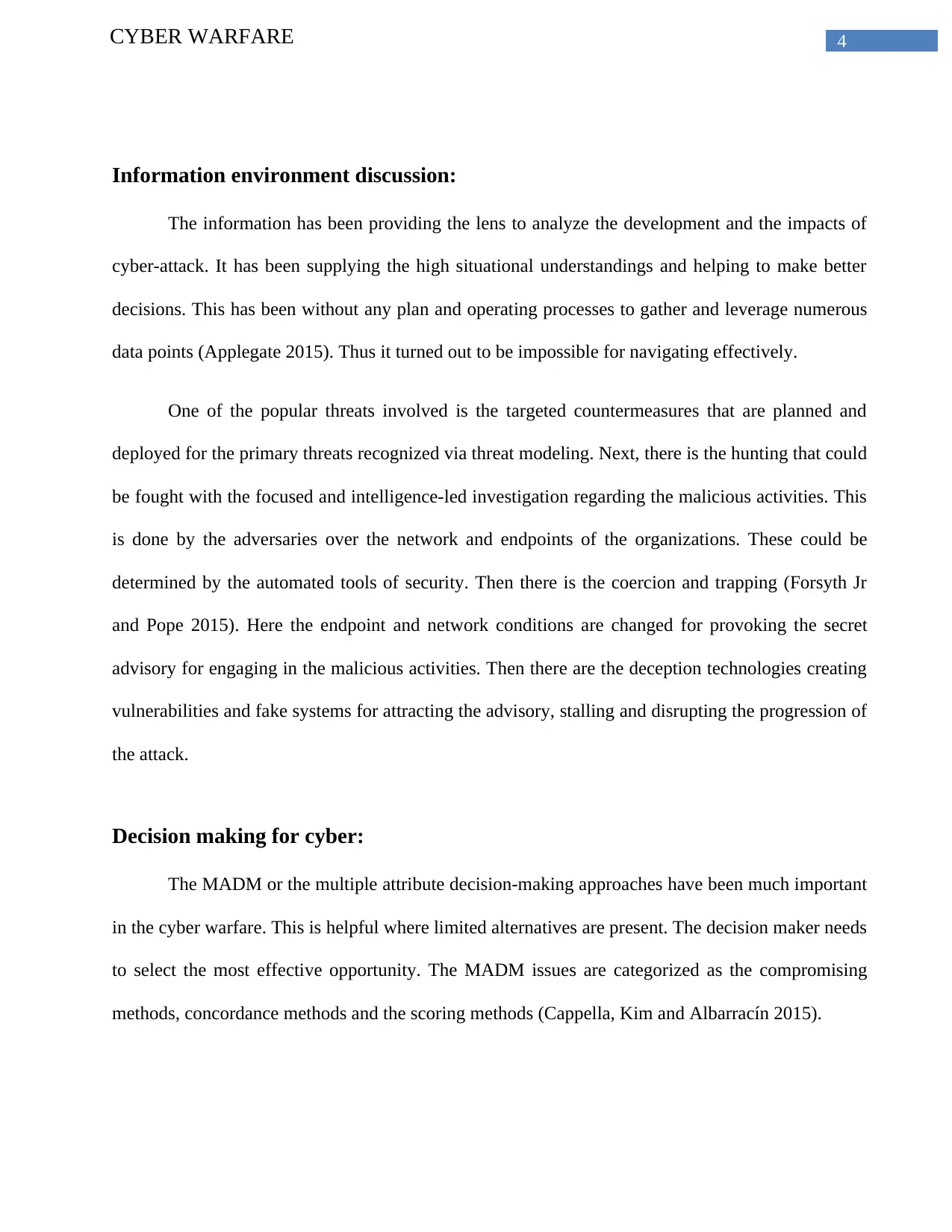
4CYBER WARFARE
Information environment discussion:
The information has been providing the lens to analyze the development and the impacts of
cyber-attack. It has been supplying the high situational understandings and helping to make better
decisions. This has been without any plan and operating processes to gather and leverage numerous
data points (Applegate 2015). Thus it turned out to be impossible for navigating effectively.
One of the popular threats involved is the targeted countermeasures that are planned and
deployed for the primary threats recognized via threat modeling. Next, there is the hunting that could
be fought with the focused and intelligence-led investigation regarding the malicious activities. This
is done by the adversaries over the network and endpoints of the organizations. These could be
determined by the automated tools of security. Then there is the coercion and trapping (Forsyth Jr
and Pope 2015). Here the endpoint and network conditions are changed for provoking the secret
advisory for engaging in the malicious activities. Then there are the deception technologies creating
vulnerabilities and fake systems for attracting the advisory, stalling and disrupting the progression of
the attack.
Decision making for cyber:
The MADM or the multiple attribute decision-making approaches have been much important
in the cyber warfare. This is helpful where limited alternatives are present. The decision maker needs
to select the most effective opportunity. The MADM issues are categorized as the compromising
methods, concordance methods and the scoring methods (Cappella, Kim and Albarracín 2015).
Information environment discussion:
The information has been providing the lens to analyze the development and the impacts of
cyber-attack. It has been supplying the high situational understandings and helping to make better
decisions. This has been without any plan and operating processes to gather and leverage numerous
data points (Applegate 2015). Thus it turned out to be impossible for navigating effectively.
One of the popular threats involved is the targeted countermeasures that are planned and
deployed for the primary threats recognized via threat modeling. Next, there is the hunting that could
be fought with the focused and intelligence-led investigation regarding the malicious activities. This
is done by the adversaries over the network and endpoints of the organizations. These could be
determined by the automated tools of security. Then there is the coercion and trapping (Forsyth Jr
and Pope 2015). Here the endpoint and network conditions are changed for provoking the secret
advisory for engaging in the malicious activities. Then there are the deception technologies creating
vulnerabilities and fake systems for attracting the advisory, stalling and disrupting the progression of
the attack.
Decision making for cyber:
The MADM or the multiple attribute decision-making approaches have been much important
in the cyber warfare. This is helpful where limited alternatives are present. The decision maker needs
to select the most effective opportunity. The MADM issues are categorized as the compromising
methods, concordance methods and the scoring methods (Cappella, Kim and Albarracín 2015).
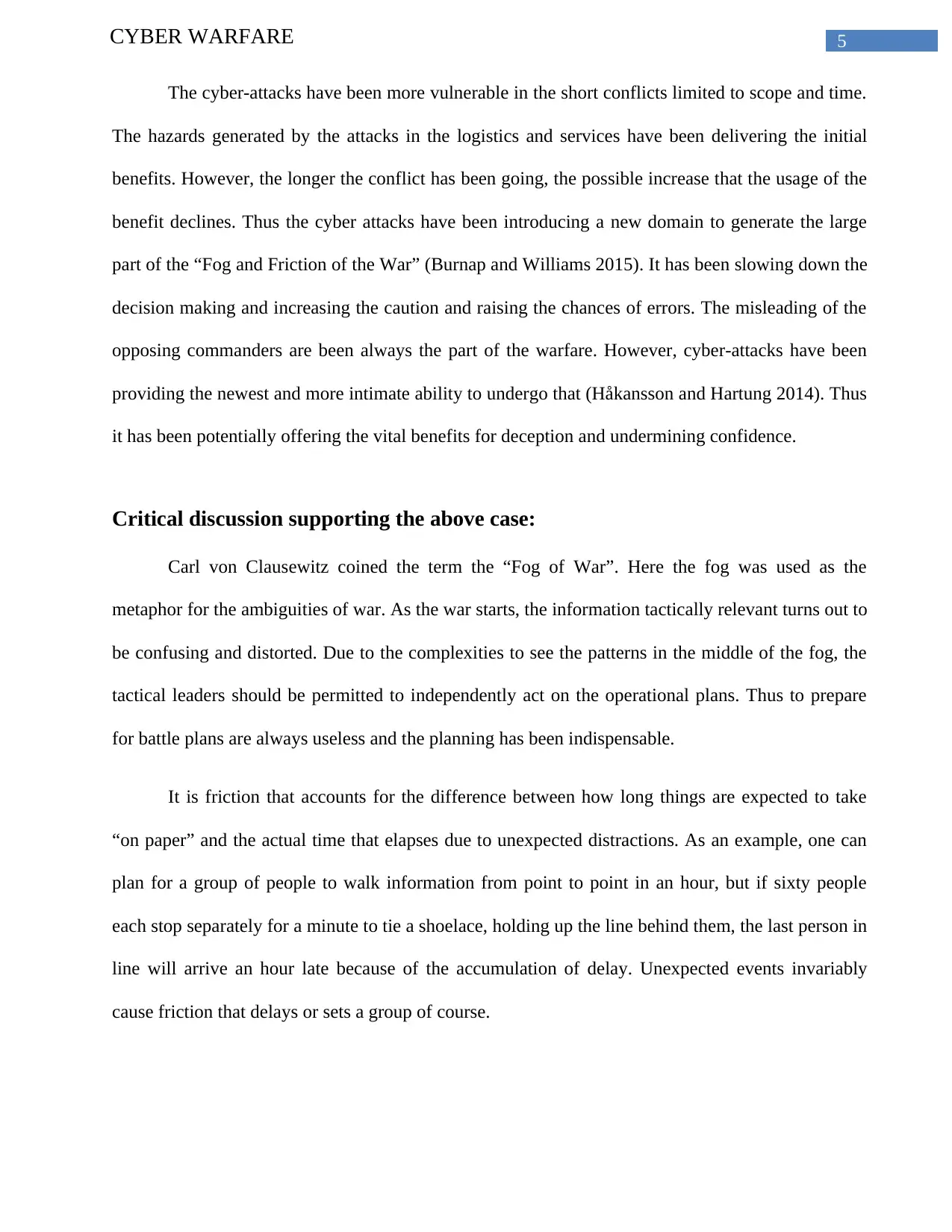
5CYBER WARFARE
The cyber-attacks have been more vulnerable in the short conflicts limited to scope and time.
The hazards generated by the attacks in the logistics and services have been delivering the initial
benefits. However, the longer the conflict has been going, the possible increase that the usage of the
benefit declines. Thus the cyber attacks have been introducing a new domain to generate the large
part of the “Fog and Friction of the War” (Burnap and Williams 2015). It has been slowing down the
decision making and increasing the caution and raising the chances of errors. The misleading of the
opposing commanders are been always the part of the warfare. However, cyber-attacks have been
providing the newest and more intimate ability to undergo that (Håkansson and Hartung 2014). Thus
it has been potentially offering the vital benefits for deception and undermining confidence.
Critical discussion supporting the above case:
Carl von Clausewitz coined the term the “Fog of War”. Here the fog was used as the
metaphor for the ambiguities of war. As the war starts, the information tactically relevant turns out to
be confusing and distorted. Due to the complexities to see the patterns in the middle of the fog, the
tactical leaders should be permitted to independently act on the operational plans. Thus to prepare
for battle plans are always useless and the planning has been indispensable.
It is friction that accounts for the difference between how long things are expected to take
“on paper” and the actual time that elapses due to unexpected distractions. As an example, one can
plan for a group of people to walk information from point to point in an hour, but if sixty people
each stop separately for a minute to tie a shoelace, holding up the line behind them, the last person in
line will arrive an hour late because of the accumulation of delay. Unexpected events invariably
cause friction that delays or sets a group of course.
The cyber-attacks have been more vulnerable in the short conflicts limited to scope and time.
The hazards generated by the attacks in the logistics and services have been delivering the initial
benefits. However, the longer the conflict has been going, the possible increase that the usage of the
benefit declines. Thus the cyber attacks have been introducing a new domain to generate the large
part of the “Fog and Friction of the War” (Burnap and Williams 2015). It has been slowing down the
decision making and increasing the caution and raising the chances of errors. The misleading of the
opposing commanders are been always the part of the warfare. However, cyber-attacks have been
providing the newest and more intimate ability to undergo that (Håkansson and Hartung 2014). Thus
it has been potentially offering the vital benefits for deception and undermining confidence.
Critical discussion supporting the above case:
Carl von Clausewitz coined the term the “Fog of War”. Here the fog was used as the
metaphor for the ambiguities of war. As the war starts, the information tactically relevant turns out to
be confusing and distorted. Due to the complexities to see the patterns in the middle of the fog, the
tactical leaders should be permitted to independently act on the operational plans. Thus to prepare
for battle plans are always useless and the planning has been indispensable.
It is friction that accounts for the difference between how long things are expected to take
“on paper” and the actual time that elapses due to unexpected distractions. As an example, one can
plan for a group of people to walk information from point to point in an hour, but if sixty people
each stop separately for a minute to tie a shoelace, holding up the line behind them, the last person in
line will arrive an hour late because of the accumulation of delay. Unexpected events invariably
cause friction that delays or sets a group of course.
⊘ This is a preview!⊘
Do you want full access?
Subscribe today to unlock all pages.

Trusted by 1+ million students worldwide
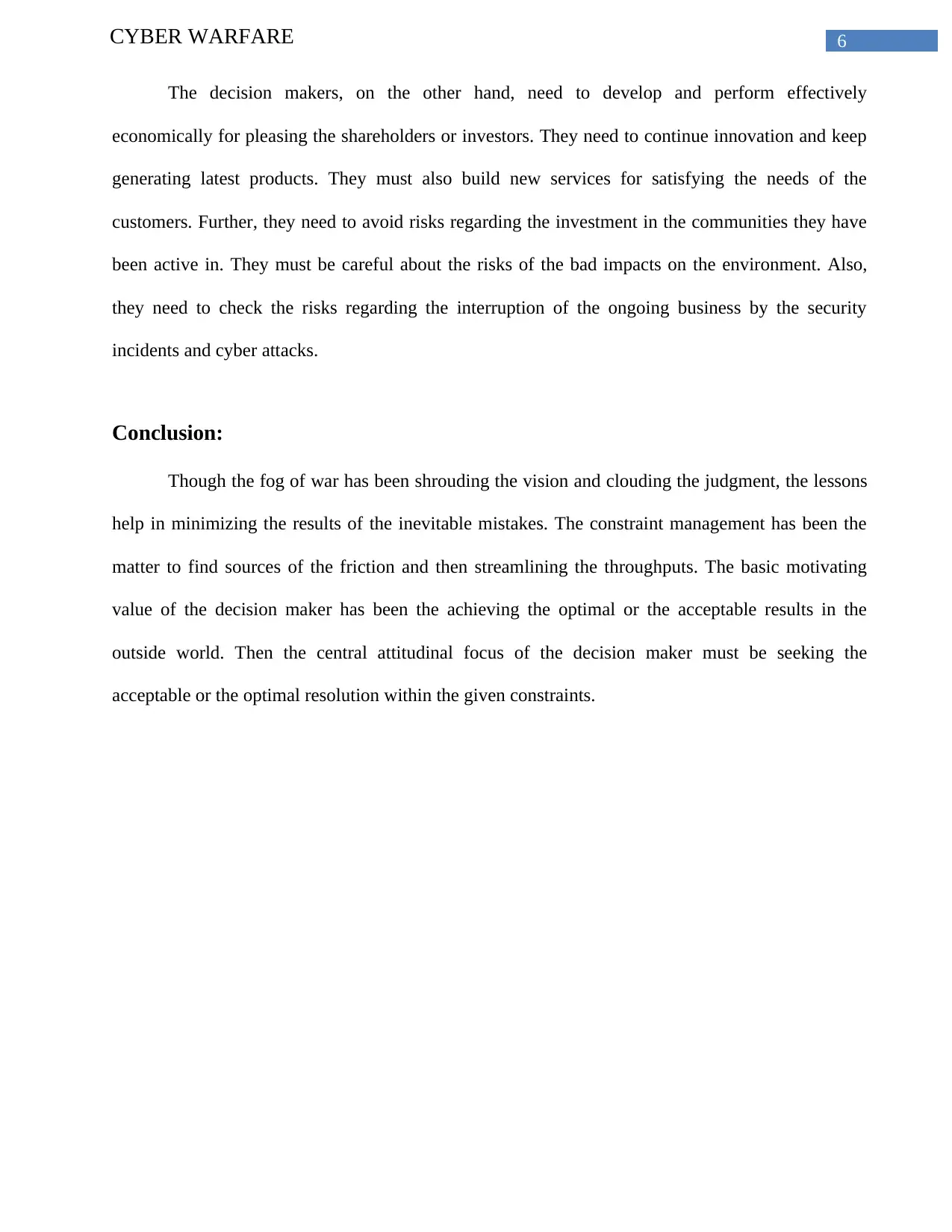
6CYBER WARFARE
The decision makers, on the other hand, need to develop and perform effectively
economically for pleasing the shareholders or investors. They need to continue innovation and keep
generating latest products. They must also build new services for satisfying the needs of the
customers. Further, they need to avoid risks regarding the investment in the communities they have
been active in. They must be careful about the risks of the bad impacts on the environment. Also,
they need to check the risks regarding the interruption of the ongoing business by the security
incidents and cyber attacks.
Conclusion:
Though the fog of war has been shrouding the vision and clouding the judgment, the lessons
help in minimizing the results of the inevitable mistakes. The constraint management has been the
matter to find sources of the friction and then streamlining the throughputs. The basic motivating
value of the decision maker has been the achieving the optimal or the acceptable results in the
outside world. Then the central attitudinal focus of the decision maker must be seeking the
acceptable or the optimal resolution within the given constraints.
The decision makers, on the other hand, need to develop and perform effectively
economically for pleasing the shareholders or investors. They need to continue innovation and keep
generating latest products. They must also build new services for satisfying the needs of the
customers. Further, they need to avoid risks regarding the investment in the communities they have
been active in. They must be careful about the risks of the bad impacts on the environment. Also,
they need to check the risks regarding the interruption of the ongoing business by the security
incidents and cyber attacks.
Conclusion:
Though the fog of war has been shrouding the vision and clouding the judgment, the lessons
help in minimizing the results of the inevitable mistakes. The constraint management has been the
matter to find sources of the friction and then streamlining the throughputs. The basic motivating
value of the decision maker has been the achieving the optimal or the acceptable results in the
outside world. Then the central attitudinal focus of the decision maker must be seeking the
acceptable or the optimal resolution within the given constraints.
Paraphrase This Document
Need a fresh take? Get an instant paraphrase of this document with our AI Paraphraser
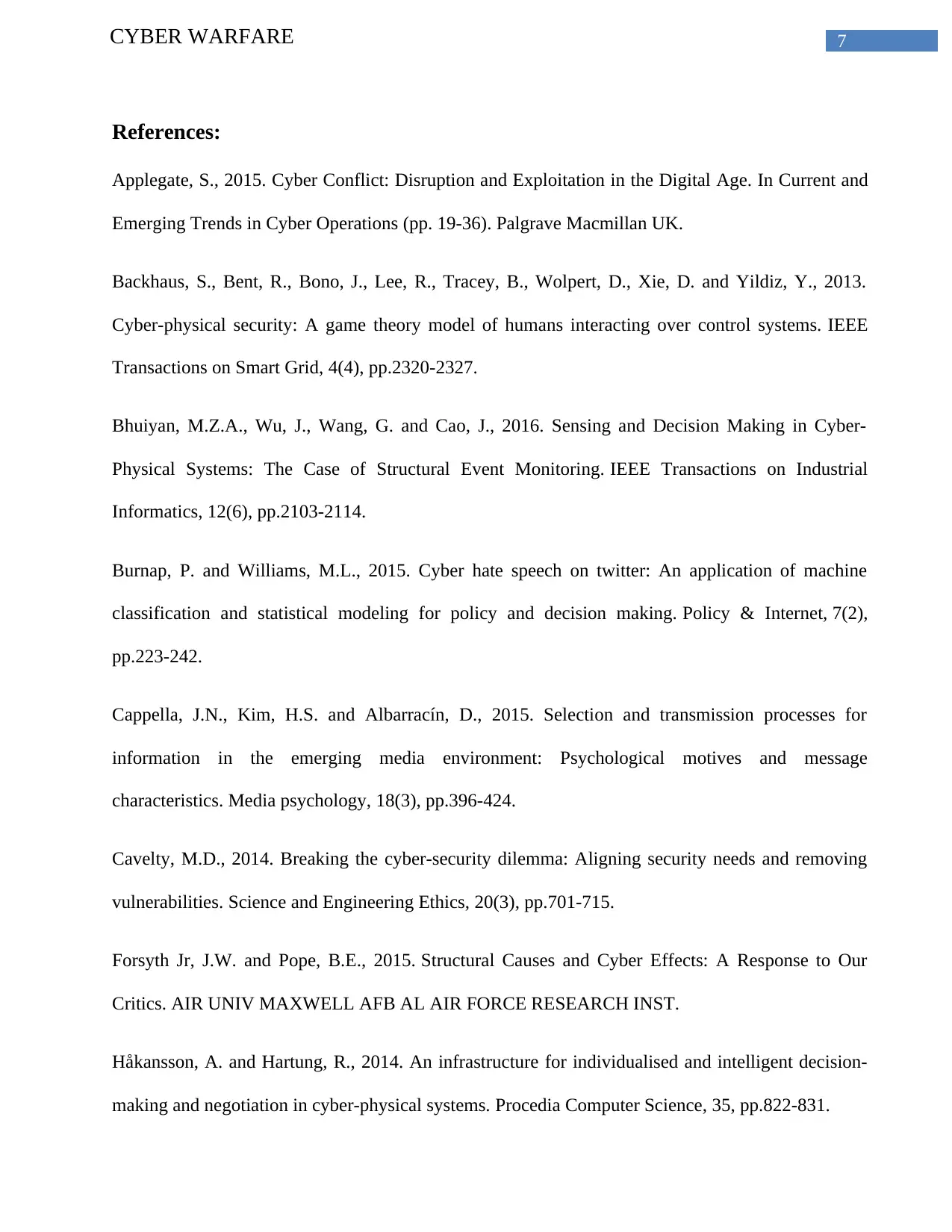
7CYBER WARFARE
References:
Applegate, S., 2015. Cyber Conflict: Disruption and Exploitation in the Digital Age. In Current and
Emerging Trends in Cyber Operations (pp. 19-36). Palgrave Macmillan UK.
Backhaus, S., Bent, R., Bono, J., Lee, R., Tracey, B., Wolpert, D., Xie, D. and Yildiz, Y., 2013.
Cyber-physical security: A game theory model of humans interacting over control systems. IEEE
Transactions on Smart Grid, 4(4), pp.2320-2327.
Bhuiyan, M.Z.A., Wu, J., Wang, G. and Cao, J., 2016. Sensing and Decision Making in Cyber-
Physical Systems: The Case of Structural Event Monitoring. IEEE Transactions on Industrial
Informatics, 12(6), pp.2103-2114.
Burnap, P. and Williams, M.L., 2015. Cyber hate speech on twitter: An application of machine
classification and statistical modeling for policy and decision making. Policy & Internet, 7(2),
pp.223-242.
Cappella, J.N., Kim, H.S. and Albarracín, D., 2015. Selection and transmission processes for
information in the emerging media environment: Psychological motives and message
characteristics. Media psychology, 18(3), pp.396-424.
Cavelty, M.D., 2014. Breaking the cyber-security dilemma: Aligning security needs and removing
vulnerabilities. Science and Engineering Ethics, 20(3), pp.701-715.
Forsyth Jr, J.W. and Pope, B.E., 2015. Structural Causes and Cyber Effects: A Response to Our
Critics. AIR UNIV MAXWELL AFB AL AIR FORCE RESEARCH INST.
Håkansson, A. and Hartung, R., 2014. An infrastructure for individualised and intelligent decision-
making and negotiation in cyber-physical systems. Procedia Computer Science, 35, pp.822-831.
References:
Applegate, S., 2015. Cyber Conflict: Disruption and Exploitation in the Digital Age. In Current and
Emerging Trends in Cyber Operations (pp. 19-36). Palgrave Macmillan UK.
Backhaus, S., Bent, R., Bono, J., Lee, R., Tracey, B., Wolpert, D., Xie, D. and Yildiz, Y., 2013.
Cyber-physical security: A game theory model of humans interacting over control systems. IEEE
Transactions on Smart Grid, 4(4), pp.2320-2327.
Bhuiyan, M.Z.A., Wu, J., Wang, G. and Cao, J., 2016. Sensing and Decision Making in Cyber-
Physical Systems: The Case of Structural Event Monitoring. IEEE Transactions on Industrial
Informatics, 12(6), pp.2103-2114.
Burnap, P. and Williams, M.L., 2015. Cyber hate speech on twitter: An application of machine
classification and statistical modeling for policy and decision making. Policy & Internet, 7(2),
pp.223-242.
Cappella, J.N., Kim, H.S. and Albarracín, D., 2015. Selection and transmission processes for
information in the emerging media environment: Psychological motives and message
characteristics. Media psychology, 18(3), pp.396-424.
Cavelty, M.D., 2014. Breaking the cyber-security dilemma: Aligning security needs and removing
vulnerabilities. Science and Engineering Ethics, 20(3), pp.701-715.
Forsyth Jr, J.W. and Pope, B.E., 2015. Structural Causes and Cyber Effects: A Response to Our
Critics. AIR UNIV MAXWELL AFB AL AIR FORCE RESEARCH INST.
Håkansson, A. and Hartung, R., 2014. An infrastructure for individualised and intelligent decision-
making and negotiation in cyber-physical systems. Procedia Computer Science, 35, pp.822-831.
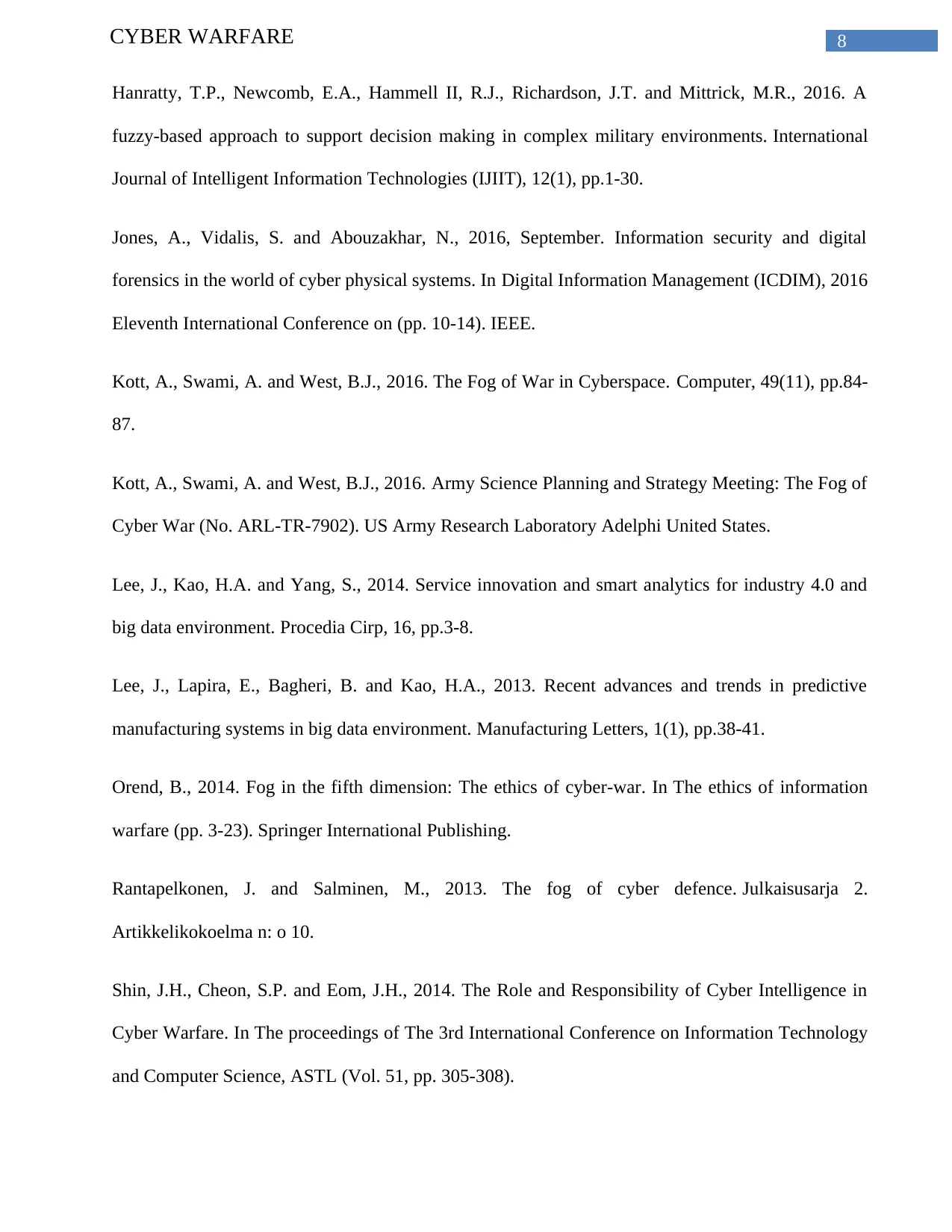
8CYBER WARFARE
Hanratty, T.P., Newcomb, E.A., Hammell II, R.J., Richardson, J.T. and Mittrick, M.R., 2016. A
fuzzy-based approach to support decision making in complex military environments. International
Journal of Intelligent Information Technologies (IJIIT), 12(1), pp.1-30.
Jones, A., Vidalis, S. and Abouzakhar, N., 2016, September. Information security and digital
forensics in the world of cyber physical systems. In Digital Information Management (ICDIM), 2016
Eleventh International Conference on (pp. 10-14). IEEE.
Kott, A., Swami, A. and West, B.J., 2016. The Fog of War in Cyberspace. Computer, 49(11), pp.84-
87.
Kott, A., Swami, A. and West, B.J., 2016. Army Science Planning and Strategy Meeting: The Fog of
Cyber War (No. ARL-TR-7902). US Army Research Laboratory Adelphi United States.
Lee, J., Kao, H.A. and Yang, S., 2014. Service innovation and smart analytics for industry 4.0 and
big data environment. Procedia Cirp, 16, pp.3-8.
Lee, J., Lapira, E., Bagheri, B. and Kao, H.A., 2013. Recent advances and trends in predictive
manufacturing systems in big data environment. Manufacturing Letters, 1(1), pp.38-41.
Orend, B., 2014. Fog in the fifth dimension: The ethics of cyber-war. In The ethics of information
warfare (pp. 3-23). Springer International Publishing.
Rantapelkonen, J. and Salminen, M., 2013. The fog of cyber defence. Julkaisusarja 2.
Artikkelikokoelma n: o 10.
Shin, J.H., Cheon, S.P. and Eom, J.H., 2014. The Role and Responsibility of Cyber Intelligence in
Cyber Warfare. In The proceedings of The 3rd International Conference on Information Technology
and Computer Science, ASTL (Vol. 51, pp. 305-308).
Hanratty, T.P., Newcomb, E.A., Hammell II, R.J., Richardson, J.T. and Mittrick, M.R., 2016. A
fuzzy-based approach to support decision making in complex military environments. International
Journal of Intelligent Information Technologies (IJIIT), 12(1), pp.1-30.
Jones, A., Vidalis, S. and Abouzakhar, N., 2016, September. Information security and digital
forensics in the world of cyber physical systems. In Digital Information Management (ICDIM), 2016
Eleventh International Conference on (pp. 10-14). IEEE.
Kott, A., Swami, A. and West, B.J., 2016. The Fog of War in Cyberspace. Computer, 49(11), pp.84-
87.
Kott, A., Swami, A. and West, B.J., 2016. Army Science Planning and Strategy Meeting: The Fog of
Cyber War (No. ARL-TR-7902). US Army Research Laboratory Adelphi United States.
Lee, J., Kao, H.A. and Yang, S., 2014. Service innovation and smart analytics for industry 4.0 and
big data environment. Procedia Cirp, 16, pp.3-8.
Lee, J., Lapira, E., Bagheri, B. and Kao, H.A., 2013. Recent advances and trends in predictive
manufacturing systems in big data environment. Manufacturing Letters, 1(1), pp.38-41.
Orend, B., 2014. Fog in the fifth dimension: The ethics of cyber-war. In The ethics of information
warfare (pp. 3-23). Springer International Publishing.
Rantapelkonen, J. and Salminen, M., 2013. The fog of cyber defence. Julkaisusarja 2.
Artikkelikokoelma n: o 10.
Shin, J.H., Cheon, S.P. and Eom, J.H., 2014. The Role and Responsibility of Cyber Intelligence in
Cyber Warfare. In The proceedings of The 3rd International Conference on Information Technology
and Computer Science, ASTL (Vol. 51, pp. 305-308).
⊘ This is a preview!⊘
Do you want full access?
Subscribe today to unlock all pages.

Trusted by 1+ million students worldwide
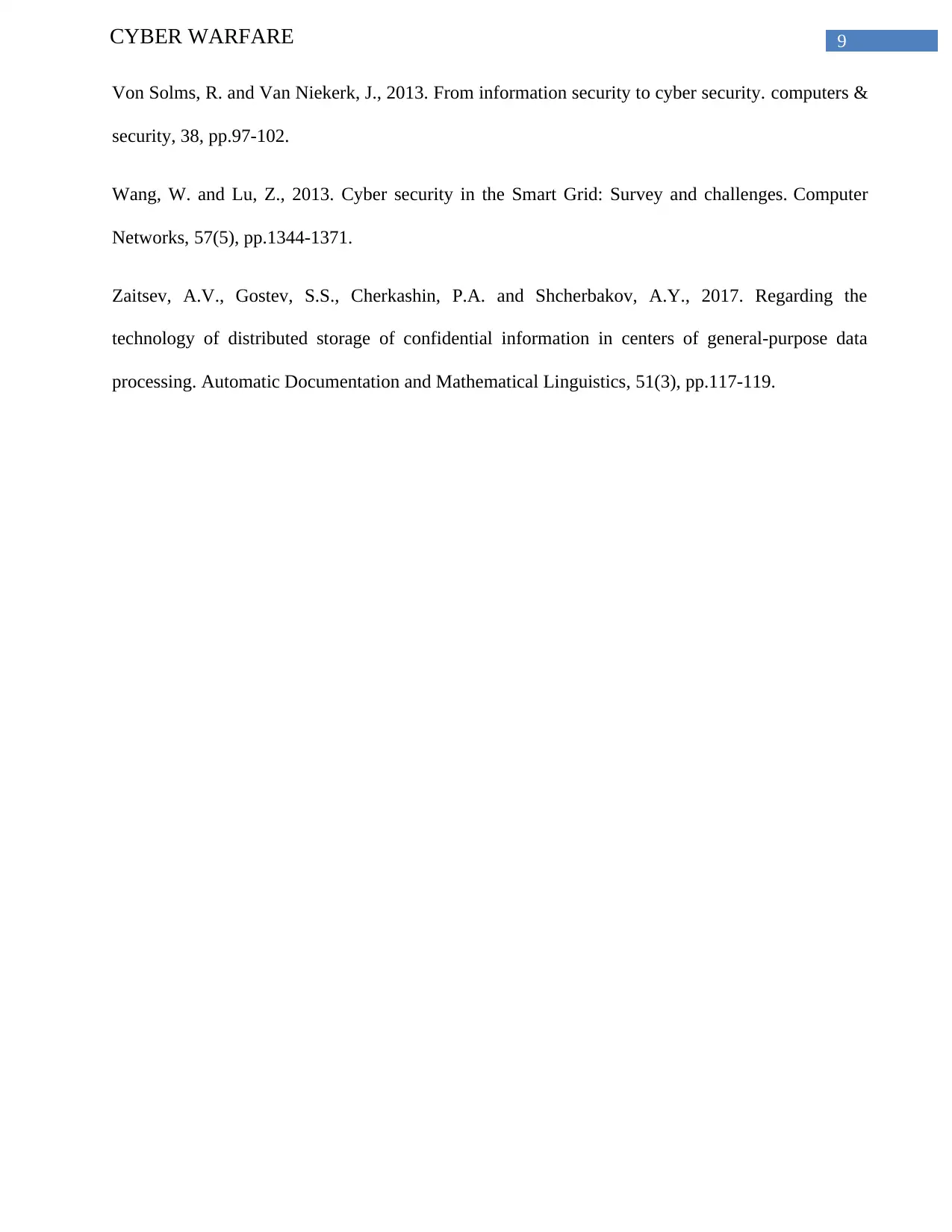
9CYBER WARFARE
Von Solms, R. and Van Niekerk, J., 2013. From information security to cyber security. computers &
security, 38, pp.97-102.
Wang, W. and Lu, Z., 2013. Cyber security in the Smart Grid: Survey and challenges. Computer
Networks, 57(5), pp.1344-1371.
Zaitsev, A.V., Gostev, S.S., Cherkashin, P.A. and Shcherbakov, A.Y., 2017. Regarding the
technology of distributed storage of confidential information in centers of general-purpose data
processing. Automatic Documentation and Mathematical Linguistics, 51(3), pp.117-119.
Von Solms, R. and Van Niekerk, J., 2013. From information security to cyber security. computers &
security, 38, pp.97-102.
Wang, W. and Lu, Z., 2013. Cyber security in the Smart Grid: Survey and challenges. Computer
Networks, 57(5), pp.1344-1371.
Zaitsev, A.V., Gostev, S.S., Cherkashin, P.A. and Shcherbakov, A.Y., 2017. Regarding the
technology of distributed storage of confidential information in centers of general-purpose data
processing. Automatic Documentation and Mathematical Linguistics, 51(3), pp.117-119.
1 out of 10
Related Documents
Your All-in-One AI-Powered Toolkit for Academic Success.
+13062052269
info@desklib.com
Available 24*7 on WhatsApp / Email
![[object Object]](/_next/static/media/star-bottom.7253800d.svg)
Unlock your academic potential
Copyright © 2020–2025 A2Z Services. All Rights Reserved. Developed and managed by ZUCOL.





